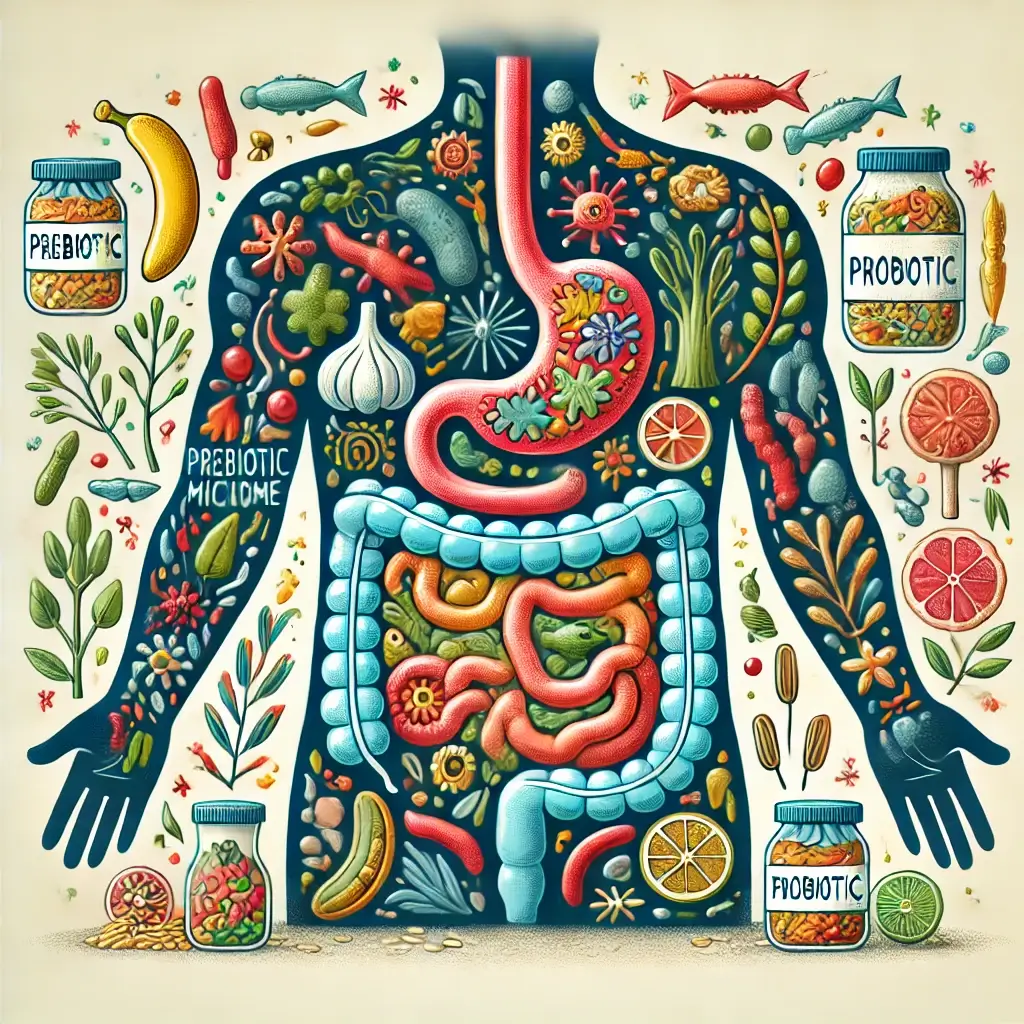Understanding the Human Gut Ecosystem
The human gut is a remarkable ecosystem of trillions of microorganisms working together to promote health. This community of bacteria, fungi, viruses, and other microbes, collectively known as the gut microbiome influences everything from digestion and nutrient absorption to immunity and even mental well-being. Maintaining a balanced gut microbiome is essential for optimal health, yet many people struggle to understand how to support their gut health effectively.
Introduction to Prebiotics and Probiotics
Two terms often associated with gut health—prebiotics and probiotics—frequently appear in discussions about digestion. While they sound similar, these components of gut health have distinct but complementary functions. Prebiotics serve as food for beneficial gut bacteria, while probiotics are live microorganisms that can supplement the existing gut microbiota. Together, they create a powerful synergy to promote digestive and overall health.
Core Focus of the Article
This article explores the differences between prebiotics and probiotics, the scientific research behind their roles, and how to incorporate them into your daily routine for improved gut health.
Understanding Prebiotics
Prebiotics are non-digestible fibers found in various plant-based foods. Unlike other nutrients that are absorbed in the stomach and small intestine, prebiotics pass through the digestive system intact and reach the colon, where they serve as a food source for beneficial gut bacteria.
The Role of Short-Chain Fatty Acids
When gut bacteria ferment prebiotics, they produce short-chain fatty acids (SCFAs), such as butyrate, acetate, and propionate. These SCFAs provide energy for colon cells, support gut barrier function, and reduce inflammation throughout the body (Gibson et al., 2017). Additionally, prebiotics encourage the growth of beneficial bacteria, leading to a more diverse gut microbiome.
Natural Sources of Prebiotics
Many common foods are rich in prebiotics. Examples include:
Fruits: Bananas, apples, and berries.
Vegetables: Onions, garlic, asparagus, and artichokes.
Whole Grains: Oats, barley, and brown rice.
Legumes: Lentils, chickpeas, and beans.
Eating a diet that includes a variety of these foods can help nourish the beneficial bacteria in your gut, promoting better digestion and overall health.
Understanding Probiotics
Probiotics are live microorganisms that, when consumed in adequate amounts, confer a health benefit to the host (Hill et al., 2014). They are often referred to as “good bacteria” because they help restore and maintain a balanced gut microbiome, particularly after disruptions caused by antibiotics, illness, or a poor diet.
Research on Probiotic Benefits
Research has shown that probiotics can enhance gut health by increasing microbial diversity, reducing harmful bacteria, and supporting immune function. Certain strains of probiotics, such as Lactobacillus and Bifidobacterium, have been studied extensively for their positive effects on digestion, including alleviating symptoms of irritable bowel syndrome (IBS) and preventing antibiotic-associated diarrhea (Ouwehand et al., 2002).
Natural Sources of Probiotics
Probiotic-rich foods include:
Yogurt with live and active cultures.
Fermented foods like kimchi, sauerkraut, and kefir.
Drinks such as kombucha and certain types of miso soup.
For individuals unable to obtain sufficient probiotics from their diet, supplements may offer an alternative. However, consulting a healthcare provider before starting any supplement regimen is essential.
Understanding the Prebiotic-Probiotic Connection
While prebiotics and probiotics each have individual benefits, they work best when combined. This synergy, known as a synbiotic relationship, enhances the effects of both. Prebiotics act as a fuel source for the probiotics, helping them establish and thrive in the gut.
Scientific Evidence of Synbiotic Benefits
For example, a study published in Nature found that synbiotic therapies were more effective in managing IBS symptoms than using either prebiotics or probiotics alone (Zuo et al., 2018). This underscores the importance of a balanced approach to gut health.
Dietary Implementation Guidelines
To optimize gut health:
Prioritize a diverse diet: Include a variety of prebiotic-rich and probiotic-rich foods.
Consider supplements: If dietary intake is insufficient, consult a healthcare provider about supplements.
Monitor your body: Pay attention to digestive changes and consult a healthcare professional if necessary.
Final Thoughts on Gut Health
Prebiotics and probiotics are essential components of a healthy gut microbiome. By providing nourishment for beneficial bacteria and introducing new strains, they contribute to improved digestion, enhanced immunity, and overall well-being. Incorporating a variety of prebiotic-rich and probiotic-rich foods into your diet, along with professional guidance when necessary, can help you achieve optimal gut health.
Research References
References
Gibson, G. R., et al. (2017). Synbiotics in health and chronic disease. Nature Reviews Gastroenterology & Hepatology, 10(11), 705-715. Link
Hill, C., et al. (2014). Expert consensus document: The International Scientific Association for Probiotics and Prebiotics consensus statement on the scope and appropriate use of the term probiotic. Nature Reviews Gastroenterology & Hepatology, 11(8), 506-514. Link
Ouwehand, A. C., et al. (2002). Probiotic and other functional microbes: From markets to mechanisms. Current Opinion in Biotechnology, 13(5), 483-487. Link
Zuo, T., et al. (2018). Gut microbiota alterations in IBS. Nature, 2(10), 321-330. Link
